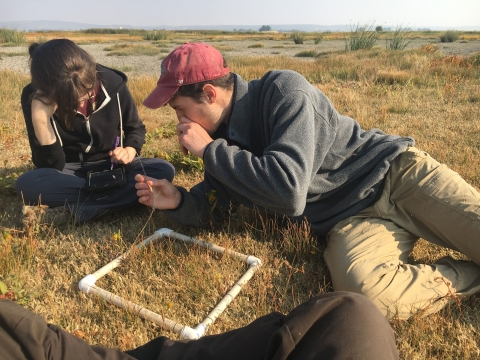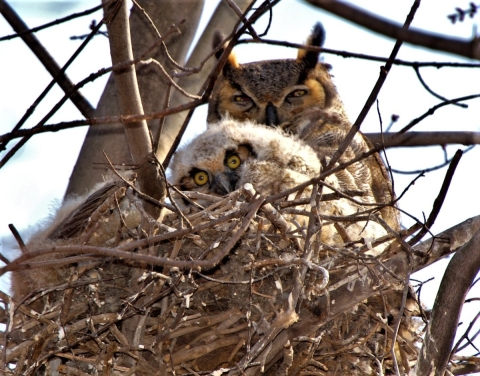Projects and Research
Learn more about our recent and ongoing projects below:
Crane Banding
Modoc National Wildlife Refuge is a stopover for many species of migrating waterfowl and birds of the Pacific Flyway, including Sandhill cranes. There are 2 main subspecies of Sandhill cranes in the Pacific Flyway, the Greater and Lesser Sandhill crane. At Modoc NWR we see both subspecies as they migrate through but some of the Greater Sandhill cranes stay for the summer. The cranes that stay at Modoc NWR pick and defend territories to nest and raise young. The young cranes, called colts, usually hatch in June and July and are watched very closely by refuge staff. Approximately 4 to 6 weeks after hatching, the colts are larger, likely to survive but can’t yet fly. This is when refuge staff attempt to capture the colt and band it with a variety of plastic, colored bands easily distinguished from a distance.
Greater Sandhill crane banding started at Modoc NWR in the mid 1980’s. With a few exceptions, many of the cranes banded on or near the refuge were banded as colts. When the cranes return, the bright combination of bands allow observers to identify the individual birds. This data has helped managers understand the crane’s extreme site fidelity (the tendency to return to a previously occupied space).
Visitors interested in seeing cranes should plan their visit sometime between March and September. The largest numbers of both Greater and Lesser Sandhill cranes are observed during the migration, March & April and August & September. Greater Sandhill cranes can be seen on territory and occasionally on a nest from April to June. Colts can be seen anytime from June to August. The auto tour drive is often the best place to see not only cranes but also ducks, shorebirds, coyotes, turtles and lots of other wildlife.
Wetland Habitat Assessment Protocol (WHAP)
A collaboration between the U.S. Fish and Wildlife Service and University of California, Davis has created a new survey for refuge managers to estimate how well the refuge meet the nutritional needs of waterfowl on refuges. Starting in 2020, Modoc National Wildlife Refuge is collecting annual data on food-plant seed production. The Wetland Habitat Assessment Protocol, referred to as WHAP, is a multi-layered data collection tool that combines measuring seed heads and estimating plant densities. This information is then rolled into an estimate of grams of seeds per acre available to waterfowl as forage. The estimate of food produced is helpful for refuge managers who carefully plan the best ways to meet the needs of the waterfowl and other critters who rely on the refuge.
The WHAP focuses on 3 wetland food-plant species, swamp timothy, watergrass and lady’s thumb smartweed. The seeds from these plants are highly nutritious and sought after by ducks and geese on the refuge. For the last 2 summers, biologists and interns spent a week looking closely at the plants and seeds across the refuge. These photos show how a measurement is taken and what a fully seeded out plant looks like. Making sure migrating and wintering waterfowl have enough food to get them through their journey and the winter is one of the goals of Modoc NWR. This survey helps refuge staff gauge how well the refuge meets that goal.
Invasive Weed Mapping
An important aspect of habitat management is invasive weed control. As part of Modoc NWR's intensive weed control program, a large weed mapping project was completed in 2012. Ten of Modoc county's most invasive weeds were mapped on refuge lands. The final product is a series of very detailed maps illustrating refuge weed infestations. These maps will be valuable tools for refuge staff while planning weed control efforts and assessing the effectiveness of the weed control program.
Facts about invasive weeds
Invasive weeds compete with native plants and grasses for resources and often displace them entirely. Native wildlife relies on native plants for survival, so as native vegetation is replaced by invasives, there are major consequences for the associated wildlife.
Pit River Floodplain Project
In 2012 an exciting project was completed adding 80 acres to the floodplain of the south fork of the Pit River. In coordination with California Waterfowl Association and local contractors, the Refuge has completed a large project converting the “North Grain Field” into Pit River floodplain. The new floodplain area adds to the previous 120 acres to create 200 contiguous acres of floodplain wetlands, which provide valuable resources to a variety of nesting and migrating birds. The project created a new channel for the river, which now meanders through the previous “North Grain Field”, emulating historic conditions of the Pit River. Tule’s were transplanted from the existing floodplain and moist soil plants were seeded into the new floodplain to promote a quick transition to a diverse wetland complex. The Refuge and it’s partners in the project are excited to see the results after all the hard work. We encourage hunters to have a look at the project, but we caution them about deep mud that is expected throughout the project area. Anyone hunting within the floodplain should be very careful.
Early Signs Point to Success
Immediately after floodup of the new floodplain habitat, bird usage looked dismal. However, after new migrants arrived, bird usage soared, and over 2,500 ducks and geese were consistently seen foraging and loafing within the project area!
Wet Meadow Irrigation Improvement
More than 50 years of consistent irrigation of the Sharkey field at Modoc NWR had eroded ditches and created a very inefficient, and sometimes ineffective, irrigation regime. In 2012 this issue was confronted in cooperation with California Waterfowl Association and a local contracting crew. Sheet piling and rock dams were installed in more than 20 of the eroded ditches to hold up and disperse water at higher elevations. Also, many of the eroded ditches were filled with material to decrease the amount of water needed to irrigate the field. The project was a huge success, and this technique will continue to be used in the future to maximize the efficiency and effectiveness of irrigation in other wet meadows.
Facts about wet meadows:
Wet meadows are very important to wildlife, and provide excellent nesting habitat for Sandhill cranes, American bitterns, and rails. In the fall and spring, migrating white-fronted, Canada, and white geese forage on the fresh green shoots available in the meadows.
Refuge Island Enhancement
For a number of years the refuge has been working hard to improve islands for nesting and migrant birds. In the past, islands were built tall above the water, creating ideal conditions for weeds like poison hemlock, perennial pepperweed, and Canada thistle. Within many wetland units the refuge has scraped down these islands to remove the weed-promoting conditions and promote growth of desirable plants. In some cases the islands are left with sparse vegetation, and become excellent loafing sites for migrating birds. In other cases, the refuge has transplanted willows, tules, and other vegetation in order to provide nesting cover and natural food sources. There is an island with willows and tree snags that hunters may use for cover, and great growth of desirable wetland plants around the edges.
Facts about island enhancement:
Habitat restoration techniques and management practices are constantly changing as we learn more about the environment and the species that use it. Modoc NWR strives to stay on the cutting edge of restoration techniques so we can offer the best possible habitat. This often means changes to historical practices that no longer provide the best options.
Nest Box Project
Many nest boxes at Modoc NWR, which are important to a variety of cavity nesting birds, had fallen into disrepair. In 2012 refuge staff located all nest boxes on the refuge to assess box conditions and create a database to help future nest box management. The refuge now has a total of nearly 100 clean and sturdy nest boxes that cater to everything from swallows to owls!
Modoc is a Hoot!
Great horned owls are a year round resident of Modoc NWR, and can often be seen perched in cottonwoods or enjoying the shade under large sage brush.



